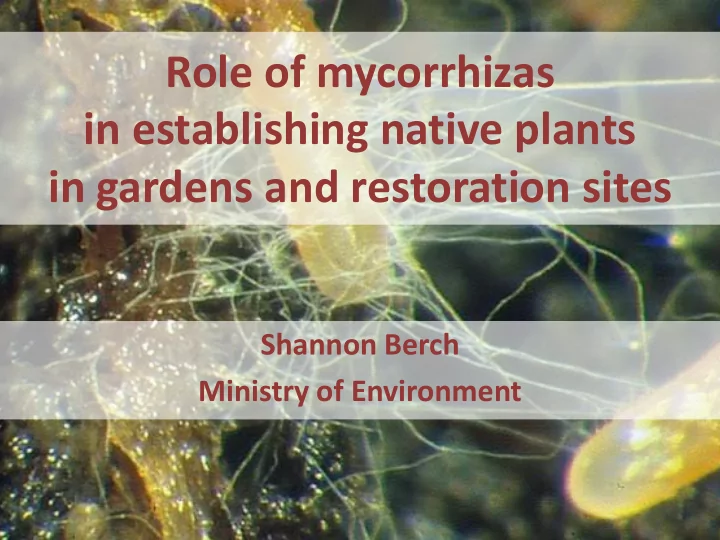

Role of mycorrhizas in establishing native plants in gardens and restoration sites Shannon Berch Ministry of Environment
What I will cover Mycorrhiza • what it is and does • different kinds – plants and fungi • practical application in nursery or field a) potting mixes b)fertilizer, fungicide c) commercial inoculum products Invasive exotic plants • role of mycorrhizas • impacts on native plants, native mycorrhizas
Commercial mycorrhizal inoculants I am illustrating examples but not advocating for any particular product.
Mycorrhiza = ‘fungus’ ‘root’ mutually beneficial association between plants and fungi fungus provides nutrients, water from soil plant provides sugars from photosynthesis
The vast majority of vascular plants are mycorrhizal Exceptions: Chenopodiaceae (Goosefoot Family) Amaranthaceae (Amaranth) Caryophyllaceae (Pinks) Polygonaceae (Buckwheat) Brassicaceae (Cruciferae, Mustard) Scrophulariaceae (Figwort) Commelinaceae (Spiderwort) Juncaceae (Rush) Cyperaceae (Sedge)
Kinds of mycorrhizas Arbuscular mycorrhiza: most plants, microfungi Ectomycorrhiza: trees, macrofungi Monotropoid mycorrhiza: Monotropa , macrofungi Orchid mycorrhiza: orchids, microfungi or macrofungi Ericoid mycorrhiza: Ericaceae, microfungi
Kinds of mycorrhizas - plants Arbuscular mycorrhiza: e.g. oceanspray, red-flowering currant, Oregon-grape (and probably most native grasses, bulbs, forbs/herbs, shrubs) Ectomycorrhiza: e.g. western hemlock, grand fir, Garry oak, arbutus Orchid mycorrhiza: e.g. elegant rein orchid Ericoid mycorrhiza: e.g. Pacific rhododendron, black huckleberry
mycorrhizal plants non-mycorrhizal plants Jim Trappe, USDA-FS Arbuscular mycorrhiza
spores vesicles arbuscules
Arbuscular mycorrhizal plants Over 80% of all land plants: angiosperms, gymnosperms, ferns annuals, perennials, grasses, shrubs, trees
Ectomycorrhiza nonmycorrhizal seedlings mycorrhizal seedlings Jim Trappe, USDA Forest Service
ectomycorrhizas of pine cross-section of ectomycorrhiza Randy Molina, USDA-FS mushrooms or truffles form ectomycorrhizas
Ectomycorrhizal plants Betulaceae (Birch Family): Alnus, Betula Corylaceae (Hazelnut): Corylus Fagaceae (Beech): Castanea, Castanopsis, Fagus, Quercus Pinaceae (Pine): Abies, Larix, Picea, Pinus, Pseudotsuga, Tsuga Salicaceae (Willow): Populus, Salix Tiliaceae (Lime): Tilia Ericaceae: Arbutus, Arctostaphylos
Orchid mycorrhizas Orchidaceae germination and protocorm Autotrophic (green) orchids: saprophytic basidiomycetes such as Tulasnella Mycoheterotrophic orchids: ectomycorrhizal basidiomycetes such as Russula Hyphal coils inside of root cells
McCormick, MK, Taylor, DL, Juhaszova, K, Burnett Jr, RK, Whigham , DF, and O’Neill, JP. 2012. Limitations on orchid recruitment: not a simple picture. Molecular Ecology 21: 1511-1523. Autotrophic orchids: Goodyera pubescens, Liparis Liliifolia, Tipularia discolor Seed packets Treatments: organic amendments (decayed wood, litter), stand age, fungal inoculation ( Tulasnella isolates from mature orchids) Main factors: fungus abundance and stand age
fungus in salal root Ericoid mycorrhiza colonized cells uncolonized cell microfungus salal on cutblock
Ericoid mycorrhizal plants Ericaceae (Heather Family): Gaultheria, Vaccinium, Rhododendron, Cassiope, Erica, Kalmia, Ledum, Phyllodoce Epacridaceae: Astroloma, Epacris, Leucopogon
Managing mycorrhizas Potting mixes Commercially available mycorrhizal inoculum Fertilizers Fungicides Tillage
Potting mix
Inoculum
Fertilizer concerns: rate of availability, amount
Fungicide concerns: systemic, root absorption
Tillage concern: breaking hyphal networks http://ic.ucsc.edu/~wxcheng/envs161/Lecture20/
Role of mycorrhizas in establishing native plants in gardens and restoration sites Factors affecting need for/success of inoculating with mycorrhizal fungi: • Mycorrhiza dependence of plant • Available nutrients – fertilizer • Availability of mycorrhizal fungus inoculum • How stressful the site is • Productivity versus persistence • Problems with propagation, establishment, productivity? Recommendation: run a preliminary experiment to determine whether inoculation helps
Invasive exotic plants Pringle, A, Bever, JD, Gardes, M, Parrent, JL, Rillig, MC, Klironomos, JN. 2009. Mycorrhizal symbioses and plant invasions. Ann. Rev. Evol. Syst. 40: 699-715. Potential for mycorrhizal symbioses to constrain or facilitate the invasion process • Does the introduced plant require mycorrhizas? (mostly mycorrhizal status is not known; when known, mostly NM or AM; pressure to lose dependence) • Is the plant flexible in associating with a range of fungal species? (AM yes, ECM ?) • Are suitable fungi transported with the plant or independently introduced to the habitat? (soil/potted plants imported, yes) Following establishment • Does the invasive plant influence their neighbours’ mycorrhizal symbioses? (NM, yes; if mycorrhizal type differs, yes; if antifungal compounds, yes; if host preferences differ, yes) • Does this influence the trajectory of the invasion? (if mycorrhizal type differs, yes) • Does this have repercussions on the native plant community? (if mycorrhizal Amanita phalloides type differs, yes) Death Cap
Invasive exotic mycorrhizal fungi Potential for commercial mycorrhizal fungi to alter the native community of mycorrhizal fungi • poorly studied • introducing same species as found locally has minimal impact (one study) • with molecular tools, can track individual fungi so this work may become more accessible • introducing exotic AM fungus can dramatically change native AM community (another study)
Conclusions • Sometimes mycorrhizal inoculation can improve plant performance (germination, production) • Commercial mycorrhizal inoculants are available • Invasive exotic plants can impact native plants and mycorrhizas • Exotic mycorrhizal fungi can impact native communities
Recommend
More recommend